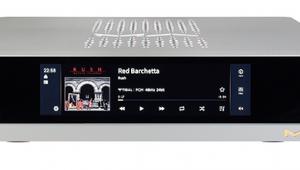Auralic Aries G2.2 Music Library/Server

 Incorporating Auralic's latest Tesla G3 streaming platform, the Aries G2.2 digital server also features a beefed-up PSU, a solid-state storage option and the promise of Dirac Live
Incorporating Auralic's latest Tesla G3 streaming platform, the Aries G2.2 digital server also features a beefed-up PSU, a solid-state storage option and the promise of Dirac Live
At Munich's High End show in May 2023, a rare appearance by Auralic founder Xuanqian Wang heralded the launch of G3 versions of its Aries streaming transport and Vega streaming DAC, destined to extend the company's reach into the high-end when they arrive later this year. Yet at the same event the digital audio specialist introduced new G2.2 iterations of the Aries (tested here) and Vega [HFN Nov '23], both now available priced £5299 and £6899, respectively. Somewhat confusingly, all four models – regardless of their generation number – use the same G3 version of Auralic's Tesla streaming platform.
Marrying an ARM-based chipset with bespoke software, 'Tesla' is the company's secret sauce. For G3, Auralic has moved to a 64-bit architecture and increased its onboard memory to 4GB. The boosted processing power of the G2.2 and G3 models also means they will be able to run Dirac Live calibration software. And regardless of Dirac – which some will find useful, but others might not – new circuit topology in the G2.2/3 hardware promises reduced latency and a claimed '90% reduction' in jitter.
A Team Player
There's also a focus this time on removing noise, with a new 'Purer-Power' PSU said to double the capacity of the G2.2 designs, while adding separate supplies for the digital audio components (the Aries G2.2 is digital-only, of course). Galvanic isolation of the USB-B port has also been improved, and you can choose whether you want to power a DAC over USB. This is a 'just in case' option as, ideally, the connected DAC will have its own (noise-free) PSU.

It isn't always obvious which Auralic box does what [see HFN Oct '22], something made harder by the company's uniform industrial design language – compared to competitors including Aurender, Lumin and HiFi Rose, it prefers a low-key, sleek approach. That hasn't changed on the Aries G2.2, as it retains the sturdy 'UnityChassis II', with nickel-plated sub-enclosure, of the G2.1 model. This has a larg(ish) display on the front, which shows album art and an interface when required, but it's not touch-enabled nor, to be frank, very necessary. Auralic's Lightning DS app is meant to be your primary way of interfacing with the unit.
The Aries G2.2 is clearly distinct from the similar-looking Vega G2.2 network DAC and the do-it-all Altair G2.1 [HFN Dec '22 – there isn't yet an Altair G2.2]. It specialises in one thing: feeding a DAC, be it a standalone unit or a digital input on an integrated amplifier or active speakers, but can be fitted with internal storage to morph into a media library/server, so is more versatile than most rival transports. In the past you (or your dealer) could slip in an SSD, but with the G2.2 platform Auralic has moved to faster PCI Express-based NVMe storage that's pre-installed in the factory. This means you need to decide when purchasing whether you want an Aries G2.2 with or without 4TB of storage. The device plays very nicely with music files on a NAS or connected via USB, of course.
Lightning Fast
Plenty of changes here, then, but Auralic is nothing if not consistent when it comes to features and app control. From its entry-level models to the elite G3 units (which, for the first time, will be built in the US), you use the same Lightning DS app and broadly speaking enjoy the same user experience. I have no complaints about that, as Lightning DS is a good reason to pick an Auralic device over other streamers. The interface is responsive and fun to use, both when playing music from your own library or when using one of the built-in streaming platforms. The selection of services currently offered is limited but includes audiophile favourites Tidal and Qobuz, plus HRA, the German-based streamer which takes a strict stance against 'fake' hi-res material. You can also play directly from Spotify or Tidal, or via AirPlay, Bluetooth, Roon or over DLNA, so the Aries G2.2 lets you listen to just about any music service.
One gripe remains, however and that's Auralic's steadfast refusal to offer the Lightning DS app on non-Apple devices. Android users who don't want to also invest in an iPad or a Macbook with an M-processor therefore need to access the Aries G2.2's settings and sound processing options via a web interface. And it's only when you enter these settings that you discover the extent of this network transport's capabilities. There's a lot you can do, including much that you won't find elsewhere, including resampling AirPlay streams and dictating what upsampling should be applied to different source sampling rates.
![]() Music Made Easy
Music Made Easy
Our Aries G2.2 was fitted into a system comprising a Primare A35.8 amplifier [HFN May '22] and Focal Sopra No2 loudspeakers [HFN Sep '15], with T+A DAC200 [HFN May '22] and Musical Fidelity M6x [HFN Jul '22] DACs. Auralic would no doubt suggest that its Vega G2.2 is a very suitable match as well, and if you take that route there's a dedicated HDMI Lightning Link to connect the devices together. You can even take it up a notch, as a second Lightning Link caters to Auralic's outboard Leo GX.1 clock.


















































